

Where Were Those MGM Cartoons When I Needed Them? --- Part One
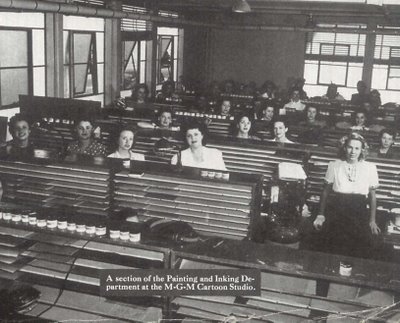
I’ll acknowledge having been a cartoon Main Titles junkie for virtually all of my life. Those logos and credits were actually more fulfilling than the short itself in many cases. Programs that excised openers and went straight to the body of the film were major downers. Walter Lantz introduced his Woody Woodpecker subjects, then went direct to a stark title card, omitting the credits. It wasn’t until these packages showed up in syndication around 1977 that I first saw a Universal logo on a Walter Lantz cartoon. Disney was as bad for depriving us of titles. The only time I can remember seeing Mickey, Donald, or Silly Symphonies on television was when one of the Mouseketeers took the little card out of its drawer to introduce that day’s cartoon. Was there even a main title on these? None that I recall, and I certainly don’t remember credits on any. Disney used shorts on the Sunday night NBC show as well, but often as not they’d fade up to the story from Walt's intro. It was only when I began collecting that I was finally able to see those neat RKO logos and United Artists legends on the main card of a W.D. subject. The frustration of going without credits was bad enough, but what about those cartoons that never showed up at all? For all I knew, Columbia never had its name on an animated product prior to Mister Magoo, and MGM’s only contribution was Tom and Jerry. I saw my first Metro Captain and The Kids shorts this morning on a DVD of A Day At The Races. I understand there were only fifteen of these, most in black-and-white. Does anyone remember seeing them in syndication? All we ever seemed to have around here in the way of vintage cartoons were Popeye and Warner Bros. Was it like this elsewhere, or was I merely deprived in North Carolina viewing markets? Metro shorts are a particular curiosity. After all, they made a lot of animated shorts. There’s not much information about the broadcast histories of those packages between the fifties and seventies (boy, would I love hearing from a station buyer from that period!), but apparently they were available from September 1960 …
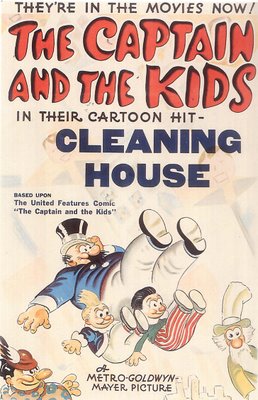


MGM cartoons were supposedly the last of the major studios’ pre-1948 animated films released to television. The deal was struck with United Artists TV Distribution, but did not include the ongoing Tom and Jerry series, which remained a popular theatrical mainstay well into the sixties. From 1960, the Metros were leased to local stations as kiddie fodder, usually filling time between live host segments. Barney Bear was an umbrella title for some of these afternoon shows, as the package contained the first fifteen entries from that series, as well as thirteen MGM Bosko shorts, fifteen Captain and The Kids, and numerous Happy Harmonies produced by Hugh Harman and Rudolpf Ising. There were 135 cartoons in the group, and 120 were in color. By the time they became available, United Artists already had much larger packages of Popeye and Warner Bros. shorts in station berths across the country. The MGM subjects were in direct competition with name-brand animated products that had a four-year head start in clearing virtually every syndicated market in the nation. How could Barney Bear compete with Bugs Bunny? It must have been hard selling cartoons with no recognizable characters. UA salesmen in the field would have found it far easier to sell a Popeye group over these Metros. I’d assume MGM cartoons wound up with those stations that had been trumped in their respective market by rivals who’d grabbed off Bugs and Daffy before they could, but a question also arises as to what sort of terms UA exacted for the Metros. My guess would be high --- their lease with MGM was probably no bargain. Is this why so few of us saw these cartoons growing up? I’ve spent the last few days asking among friends around the country, and none of them recall seeing a Happy Harmonies on television (especially prior to the late seventies).
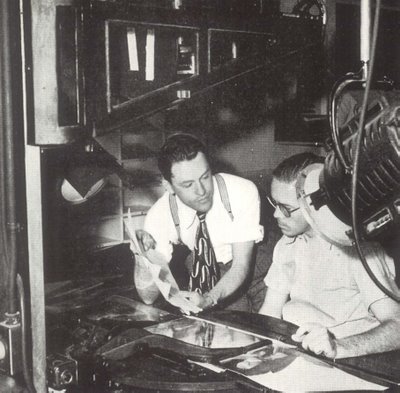
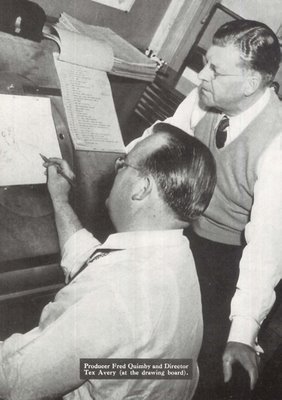
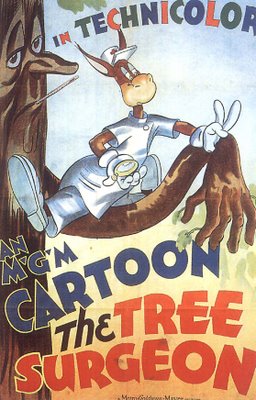
Owning MGM cartoons on 16mm conferred bragging rights unequalled by the more commonplace WB’s. Finding them was near impossible. A company called Pictoreel sold Harman and Ising shorts (that's Harman and cameraman Jack Stevens in the photo above left) outright during the fifties, and home viewers could pick these up in either black-and-white or Kodachrome prints. It would appear the two producers retained some kind of distribution rights in these subjects, as other MGM cartoons were never legitimately available to collectors in 16mm. As for random or scattered prints (that is, ones mislaid or otherwise appropriated from TV stations or rental houses), you’d grab a Metro almost sight unseen in those days. Often as not, they’d be pink --- which is to say, the color was faded or fading. All were pigs in a poke since we’d seldom or never seen them before on TV. Much of the time, that was OK, but there were disasters. I scooped up six MGM’s around 1976 for $30 each, which wasn’t bad for such rarities. The first one I watched was The Old Plantation, which had all the rich animation and lavish backgrounds one might expect from Metro. Up next was a cartoon so dreadful that the mere recollection of it sets my teeth on edge. The Tree Surgeon was surely the most nauseating seven minutes I ever spent in front of a 16mm tri-pod screen. I still have flashbacks from the experience. My request to Warners --- now that you own this negative, please burn it. Collecting cartoons got easier when TV stations started dumping them in the late eighties. Suddenly, there were entire runs of Tom and Jerry (they’d finally gone off-network and into syndication in 1977), and even the legendary Tex Avery shorts were starting to turn up. Some friends and I used to meet a longtime collector/dealer on the third Saturday of each month at a Shoney’s restaurant near Charlotte. After lunch, he’d pop the trunk and we’d do a deal for MGM cartoons out in the parking lot. He had a friend at one of the TV stations and they were converting over to videotape for all their programming. What we got would have otherwise been earmarked for the dumpster, had not reason prevailed. There were VCR’s by then, but nothing approached the quality and purity of these classics on 16mm, and besides, the prints were in virtually new condition. It was only after all the TV stations/rental houses were emptied that the supply began to dwindle out. By then, so was collecting, for now there was video projection and the remarkable clarity of DVD. We’d have never imagined it would end, but now it pretty much has. The old Big Reel newspaper we anticipated with such fervor each month has slimmed down to wafer size, and whatever’s left of 16mm gathering is now largely confined to e-bay. It was all great while it lasted, but film couldn’t survive in the face of digital technology (even theatres are abandoning it now!). Some of you veteran collectors out there should write a history of that vanished era. In tomorrow’s Part Two, I promise not to digress so far from MGM cartoons, for there’s more info at hand about costs and rentals, as well as how the studio used their animated subjects as a battering ram against the despised double feature policy.
